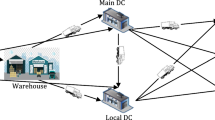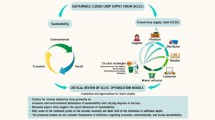Abstract
For large multinational companies, the complex production process of their finished goods usually contains plenty of stages, which constitute a production flow network. Each production stage in the production flow network can be undertaken by one or more suppliers. This study proposes a stochastic programming model for the production flow network oriented supply chain network design problem, which optimizes the decision of allocating stages to suppliers with the objective of minimizing the total expected costs of production and transportation among suppliers under uncertain demands of customers. A local branching based solution method is developed to solve the model. A case study on applying this model to a large automobile company is performed. In addition, some numerical experiments are conducted to validate the effectiveness of the proposed model and the efficiency of the proposed solution method.
Similar content being viewed by others
References
Ahmadi-Javid, A. & Hoseinpour, P. (2015). Incorporating location, inventory and price decisions into a supply chain distribution network design problem. Computers & Operations Research, 56: 110–119.
Akeb, H., Hifi, M. & Mounir, M. E. O. A. (2011). Local branching-based algorithms for the disjunctively constrained knapsack problem. Computers & Industrial Engineering, 60: 811–820.
Altiparmak, F., Gen, M., Lin, L. & Karaoglan, I. (2009). A steady-state genetic algorithm for multi-product supply chain network design. Computers & Industrial Engineering, 56(2): 521–537.
Asian, S. & Nie, X. (2014). Coordination in supply chains with uncertain demand and disruption risks: existence, analysis, and insights. IEEE Transactions on Systems, Man, and Cybernetics: Systems, 44(9): 1139–1154.
Baghalian, A., Rezapour, S. & Farahani, R. Z. (2013). Robust supply chain network design with service level against disruptions and demand uncertainties: a real-life case. European Journal of Operational Research, 227(1): 199–215.
Costa, A., Celano, G., Fichera, S. & Trovato, E.(2010). A new efficient encoding/decoding procedure for the design of a supply chain network with genetic algorithms. Computers & Industrial Engineering, 59(4): 986–999.
Danna, E., Rothberg, E. & Pape, C. Le. (2005). Exploring relaxation induced neighborhoods to improve MIP solutions. Mathematical Programming, 102: 71–90.
Dotoli, M., Fanti, M. P., Meloni, C. & Zhou, M. (2006). Design and optimization of integrated e-supply chain for agile and environmentally conscious manufacturing. IEEE Transactions on Systems, Man, and Cybernetics, Part A: Systems and Humans, 36(1): 62–75.
Eskigun, E., Uzsoy, R., Preckel, P. V., Beaujon, G., Krishnan, S. & Tew, J. D. (2005). Outbound supply chain network design with mode selection, lead times and capacitated vehicle distribution centers. European Journal of Operational Research, 165(1): 182–206.
Fischetti, M. & Lodi, A. (2003). Local branching. Mathematical Programming, 98: 23–47.
Gedik, R., Medal, H., Rainwater, C., Pohl, E. A. & Mason, S. J. (2014). Vulnerability assessment and re-routing of freight trains under disruptions: a coal supply chain network application. Transportation Research, Part E, 71: 45–57.
Georgiadis, M. C., Tsiakis, P., Longinidis, P. & Sofioglou, M. K. (2011). Optimal design of supply chain networks under uncertain transient demand variations. Omega, 39(3): 254–272.
Govindan, K., Jafarian, A., Khodaverdi, R. & Devika, K. (2014). Two-echelon multiple-vehicle location-routing problem with time windows for optimization of sustainable supply chain network of perishable food. International Journal of Production Economics, 152: 9–28.
Hasani, A., Zegordi, S. H. & Nikbakhsh, E. (2015). Robust closed-loop global supply chain network design under uncertainty: the case of the medical device industry. International Journal of Production Research, 53(5): 1596–1624.
Klibi, W. & Martel, A. (2012). Scenario-based supply chain network risk modeling. European Journal of Operational Research, 223(3): 644–658.
Lin, C.-C. & Wang, T.-H. (2011). Build-to-order supply chain network design under supply and demand uncertainties. Transportation Research, Part B, 45(8): 1162–1176.
Mahnam, M., Yadollahpour, M. R., Famil-Dardashti, V & Hejazi, S. R. (2009). Supply chain modeling in uncertain environment with bi-objective approach. Computers & Industrial Engineering, 56(4): 1535–1544.
Marufuzzaman, M., Eksioglu, S. D. & Huang, Y. (2014). Two-stage stochastic programming supply chain model for biodiesel production via wastewater treatment. Computers & Operations Research, 49: 1–17.
Melo, M. T., Nickel, S. & Saldanha da Gama, F. (2006). Dynamic multi-commodity capacitated facility location: a mathematical modeling framework for strategic supply chain planning. Computers & Operations Research, 33(1): 181–208.
Nagurney, A., Dong, J. & Zhang, D.(2002). A supply chain network equilibrium model. Transportation Research, Part E, 38(5): 281–303.
Nagurney, A. & Matsypura, D. (2005). Global supply chain network dynamics with multicriteria decision-making under risk and uncertainty. Transportation Research, Part B, 41(6): 585–612.
Nagurney, A., Yu, M., Floden, J. & Nagurney, L. S. (2014). Supply chain network competition in time-sensitive markets. Transportation Research, Part E, 70: 112–127.
Nickel, S., Saldanha-da-Gama, F. & Ziegler, H.-P. (2012). A multi-stage stochastic supply network design problem with financial decisions and risk management. Omega, 40(5): 511–524.
Park, S., Lee, T.-E. & Sung, C. S. (2010). A three-level supply chain network design model with risk-pooling and lead times. Transportation Research, Part E, 46(5): 563–581.
Peidro, D., Mula, J., Jiménez, M. & Botella, M. D. M. (2010). A fuzzy linear programming based approach for tactical supply chain planning in an uncertainty environment. European Journal of Operational Research, 205(1): 65–80.
Sadjady, H. & Davoudpour, H. (2012). Two-echelon, multi-commodity supply chain network design with mode selection, lead-times and inventory costs. Computers & Operations Research, 39(7): 1345–1354.
Santoso, T., Ahmed, S., Goetschalckx, M. & Shapiro, A. (2005). A stochastic programming approach for supply chain network design under uncertainty. European Journal of Operational Research, 167: 96–115.
Sniedovich, M. & Voß, S. (2006). The corridor method: a dynamic programming inspired metaheuristic. Control and Cybernetics, 35: 551–578.
Taillard, E. & Voß, S. (2002). POPMUSIC-A partial optimization metaheuristic under special intensification conditions. In C.C. Ribeiro and P. Hansen (eds), Essays and Surveys in Metaheuristics, pp. 613–629. Kluwer, Boston.
Tiwari, A., Chang, P.C. & Tiwari, M.K. (2012). A highly optimised tolerance-based approach for multi-stage, multi-product supply chain network design. International Journal of Production Research, 50(19): 5430–5444.
Wang, S. & Meng, Q. (2014). Liner shipping network design with deadlines. Computers & Operations Research, 41: 140–149.
Wang, S., Liu, Z. & Bell, M. G. H.(2015). Profit-based maritime container assignment models for liner shipping networks. Transportation Research, Part B, 72: 59–76.
Wu, Y. (2010). A time staged linear programming model for production loading problems with import quota limit in a global supply chain. Computers & Industrial Engineering, 59(4): 520–529.
Wu, Y., Dong, M., Fan, T. & Liu, S. (2012). Performance evaluation of supply chain networks with assembly structure under system disruptions. Computers & Operations Research, 39(12): 3229–3243.
Zhang, G., Shang, J. & Li, W. (2011). Collaborative production planning of supply chain under price and demand uncertainty. European Journal of Operational Research, 215(3): 590–603.
Zhen, L. & Wang, K. (2015). A stochastic programming model for multi-product oriented multi-channel component replenishment. Computers & Operations Research, 60: 79–90.
Zhen, L. & Wang, K., Liu, H. (2015). Disaster relief facility network design in metropolises. IEEE Transactions on Systems Man and Cybernetics: Systems, 45: 751–761.
Zhen, L. (2015). Tactical berth allocation under uncertainty. European Journal of Operational Research, 247:928–944.
Author information
Authors and Affiliations
Corresponding author
Additional information
Lu Zhen is a professor in School of Management, Shanghai University, Shanghai, China. He obtained both the B.E. and the Ph.D. degrees from Shanghai Jiao Tong University. His research interests focus on logistics and supply chain management. He has published over thirty papers on international journals such as Transportation Science, European Journal of Operational Research.
Dan Zhuge is a graduate student in School of Management, Shanghai University, Shanghai, China. Her major is management science and engineering, and her research interest focuses on logistics and supply chain management.
Jingqi Lei is a graduate student in School of Management, Shanghai University, Shanghai, China. Her major is logistic engineering, and her research interest focuses on logistics and supply chain management.
Rights and permissions
About this article
Cite this article
Zhen, L., Zhuge, D. & Lei, J. Supply chain optimization in context of production flow network. J. Syst. Sci. Syst. Eng. 25, 351–369 (2016). https://doi.org/10.1007/s11518-016-5304-6
Published:
Issue Date:
DOI: https://doi.org/10.1007/s11518-016-5304-6




